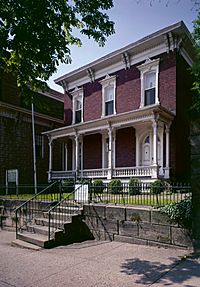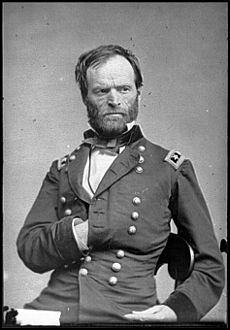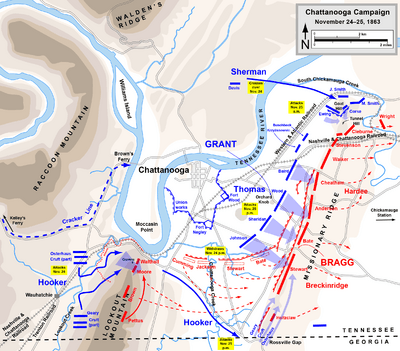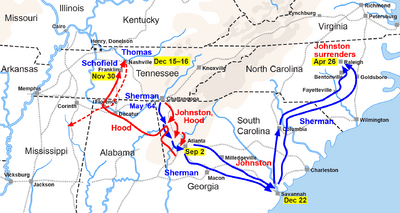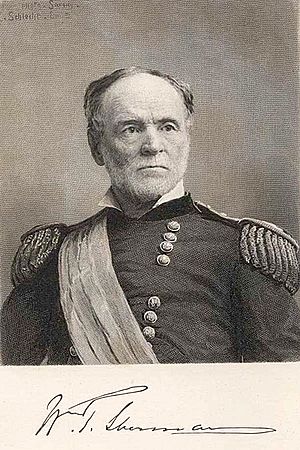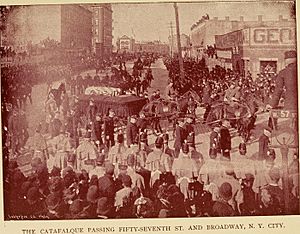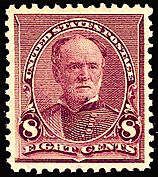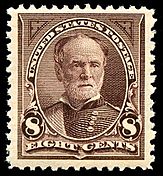William Tecumseh Sherman facts for kids
Quick facts for kids
William Tecumseh Sherman
|
|
|---|---|

Maj. Gen. William T. Sherman, USA, in May 1865. The black ribbon around his left arm is a sign of mourning over President Lincoln's death. Portrait by Mathew Brady.
|
|
| Nickname(s) | Cump, Uncle Billy (by his troops) |
| Allegiance | |
| Service/ |
United States Army Union Army |
| Years of service | 1840–53, 1861–84 |
| Rank | Major General (Civil War), General of the Army of the United States (postbellum) |
| Commands held | Army of the Tennessee (1863), Military Division of the Mississippi (1864), Commanding General of the United States Army (postbellum) |
| Battles/wars | American Civil War -Shiloh, - Vicksburg Campaign, - Chattanooga, - Atlanta Campaign, - March to the Sea, - Carolinas Campaign |
| Awards | Thanks of Congress (1864 and 1865) |
| Other work | Bank president, lawyer, university superintendent, streetcar executive |
| Signature | |
William Tecumseh Sherman (February 8, 1820 – February 14, 1891) was an American soldier, businessman, teacher, and writer. He became a very important general in the Union Army during the American Civil War (1861–1865). He was known for his amazing military plans. However, he also faced criticism for his tough "scorched earth" tactics. These tactics involved destroying things to weaken the Confederate States.
Sherman started his Civil War service in 1861. He fought in the First Battle of Bull Run and in Kentucky. He served under General Ulysses S. Grant in 1862 and 1863. They fought in battles like Fort Henry, Fort Donelson, and the Battle of Shiloh. He also helped capture Vicksburg on the Mississippi River. This was a major win for the Union. He also took part in the Chattanooga Campaign, where Confederate armies in Tennessee were defeated.
In 1864, Sherman took over from Grant as the Union commander in the western part of the war. He led his troops to capture Atlanta. This victory helped Abraham Lincoln get re-elected as president. Sherman's famous march through Georgia and the Carolinas further weakened the Confederacy. In April 1865, he accepted the surrender of all Confederate armies in the Carolinas, Georgia, and Florida.
When Grant became U.S. president in 1869, Sherman became the Commanding General of the United States Army. He held this position from 1869 to 1883. He was in charge of the U.S. Army's involvement in the Indian Wars during this time. Sherman believed in using strong military action against Native American tribes who resisted. In 1875, he published his Memoirs, which is a well-known account of the Civil War. A famous historian, B. H. Liddell Hart, called Sherman "the first modern general."
Contents
Early Life and Family
William Tecumseh Sherman was born in 1820 in Lancaster, Ohio. His father, Charles Robert Sherman, was a successful lawyer. He died suddenly in 1829, leaving his mother with eleven children and no money. After his father's death, nine-year-old William was raised by a family friend, Thomas Ewing, Sr.. Ewing was a well-known lawyer and politician. He served as a senator and the first Secretary of the Interior.
Sherman had several notable siblings. His older brother, Charles Taylor Sherman, became a federal judge. His younger brother, John Sherman, served as a U.S. senator. Another younger brother, Hoyt Sherman, was a successful banker. Two of his foster brothers also became major generals in the Union Army during the Civil War. Sherman later married his foster sister, Ellen Boyle Ewing, and they had eight children.
Sherman's Names
Sherman's unique middle name, Tecumseh, came from his father. His father admired the great Shawnee chief, Tecumseh. As an adult, Sherman always signed his letters "W.T. Sherman." His friends and family often called him "Cump."
Military Training and Early Service
In 1836, Senator Ewing helped the 16-year-old Sherman get into the United States Military Academy at West Point. There, he became good friends with George Henry Thomas, another future Civil War General. Sherman did well in his studies, especially in drawing, chemistry, and math.
After graduating in 1840, Sherman joined the Army as a second lieutenant. He fought in Florida during the Second Seminole War. He was later stationed in Georgia and South Carolina. While many of his classmates fought in the Mexican–American War, Sherman worked on administrative duties in California. He helped confirm that gold had been discovered, which started the California Gold Rush. Sherman earned a promotion to captain for his good service. However, he was disappointed not to have seen combat.
Marriage and Business Life
In 1850, Sherman married his foster sister, Ellen Boyle Ewing. They had eight children. Ellen was a devout Roman Catholic, and their children were raised in that faith.
In 1853, Sherman left the army and became a bank manager in San Francisco. This was a very busy time in California. He later moved to New York for the same bank. When the bank failed in 1857, he closed the New York branch. In 1858, he tried working as a lawyer in Kansas, but it wasn't very successful.
Leading a Military College
In 1859, Sherman became the first superintendent of the Louisiana State Seminary of Learning & Military Academy in Pineville, Louisiana. This school later became Louisiana State University (LSU). He was a popular and effective leader.
Even though his brother was against slavery, Sherman did not oppose it. He understood why Southerners defended it. However, he was strongly against the Southern states leaving the Union. When South Carolina left the United States, Sherman warned a friend: "You people of the South don't know what you are doing. This country will be drenched in blood, and God only knows how it will end. War is a terrible thing! You are rushing into war with one of the most powerful, and determined people on Earth. You are bound to fail."
He accurately predicted the four years of war that followed. In January 1861, as more Southern states left the Union, Sherman resigned his position. He returned to the North, stating he would never do anything against the United States.
Civil War Service
Early Days and Bull Run
After leaving Louisiana, Sherman went to Washington, D.C. He met with Abraham Lincoln. Sherman was worried about the North's lack of preparation for war. He later became a colonel in the 13th U.S. Infantry Regiment. He fought in the First Battle of Bull Run in July 1861. The Union lost this battle, which made Sherman doubt himself. However, President Lincoln was impressed by Sherman and promoted him to brigadier general.
Challenges and Recovery
After taking command in Kentucky, Sherman became very worried about the war. He complained about shortages and thought the Confederate forces were much stronger than they were. He was replaced and took a leave to recover. By December 1861, he was well enough to return to duty under Major General Henry Halleck. Sherman provided support for General Ulysses S. Grant's operations. He wrote to Grant, "I feel anxious about you... but [I] have faith in you—Command me in any way."
Battle of Shiloh

Sherman's first big test under Grant was at the Battle of Shiloh in April 1862. The Confederate attack surprised most Union commanders. Sherman had not believed reports that the Confederates would attack. He took few precautions.
Despite being unprepared, Sherman quickly gathered his division. He led an organized retreat that helped prevent a complete Union defeat. At the end of the day, he found Grant and said, "Well, Grant, we've had the devil's own day, haven't we?" Grant calmly replied, "Yes. Lick 'em tomorrow, though." Sherman was key to the successful Union counterattack the next day. He was wounded twice and had three horses shot from under him. Grant and Halleck praised his actions. Sherman was promoted to major general.
Vicksburg Campaign
Sherman and Grant developed a close friendship. This helped their careers. During the long campaign to capture Vicksburg, some newspapers criticized Grant and Sherman.
Sherman's military record in 1862–1863 was mixed. In December 1862, his forces were defeated at the Battle of Chickasaw Bayou near Vicksburg. However, he performed well in the main Vicksburg Campaign in the spring of 1863 under Grant's leadership.
Chattanooga Battles
After Vicksburg surrendered in July 1863, Sherman was promoted to brigadier general in the regular army. His nine-year-old son, Willie, died from typhoid fever during a visit to his camp.
Grant was given overall command in the West, and Sherman took over Grant's previous command, the Army of the Tennessee. Sherman's troops were sent to help the Union army besieged in Chattanooga, Tennessee. In November, during the Chattanooga Campaign, Sherman's efforts helped the Union win a major victory.
Atlanta Campaign
Sherman had Grant's full trust. In spring 1864, Lincoln put Grant in charge of all Union armies. Grant then appointed Sherman to lead the Union troops in the Western part of the war. Sherman's soldiers called him "Uncle Billy."
Sherman invaded Georgia with three armies. He used clever maneuvers against Confederate General Joseph E. Johnston's army. He only tried a direct attack once, at the Battle of Kennesaw Mountain, which was a disaster. In July, the cautious Johnston was replaced by the more aggressive John Bell Hood. Hood's direct attacks played into Sherman's hands.
Sherman successfully captured Atlanta on September 2, 1864. This made Sherman famous and helped Lincoln win re-election in November. The capture of Atlanta was a huge boost for the Union. After taking the city, Sherman ordered all military buildings in Atlanta to be burned. Many private homes were also destroyed. This set a pattern for his army's future actions.
March to the Sea
In September and October, Sherman decided to cut off his supply lines and march south through Georgia. He told Grant he would "make Georgia howl." Sherman left other Union forces to deal with Hood's army. Meanwhile, Sherman began his march with 62,000 men to Savannah. His army lived off the land and caused over $100 million in damage. Sherman called this "hard war," a type of total war. His troops captured Savannah on December 21, 1864. Sherman famously sent a message to Lincoln, offering the city as a Christmas present.
Sherman's success in Georgia was widely reported in the North. While in Savannah, Sherman learned that his infant son, Charles, had died.
Final Campaigns in the Carolinas
Grant wanted Sherman to join the fight against Robert E. Lee in Virginia. But Sherman convinced Grant to let him march north through the Carolinas. He wanted to destroy everything of military value, just like he did in Georgia. He especially wanted to target South Carolina, the first state to leave the Union. His army faced little resistance from Confederate General Joseph E. Johnston's troops.
Sherman captured Columbia, the state capital, on February 17, 1865. Fires started that night and destroyed most of the city. The burning of Columbia is still debated today. Some say it was accidental, others say it was deliberate. Sherman's final major battle was a victory over Johnston's troops at the Battle of Bentonville in March.
In late March, Sherman met with Grant and Lincoln at City Point, Virginia. This was the only time the three met during the war.
Confederate Surrender
After Lee surrendered to Grant, Sherman met with Johnston in North Carolina to discuss a Confederate surrender. Sherman agreed to generous terms, thinking they matched Lincoln's ideas. However, Sherman did not have the authority to offer such terms.
The government in Washington, D.C., rejected Sherman's terms. The Secretary of War, Edwin M. Stanton, publicly criticized Sherman. This caused a long disagreement between them. On April 26, 1865, Johnston agreed to purely military terms. He formally surrendered his army and all Confederate forces in the Carolinas, Georgia, and Florida. This was the largest surrender of the war. Sherman then marched with 60,000 of his troops in the Grand Review of the Armies in Washington, D.C.
Slavery and Freedom
Before the war, Sherman was not against slavery. He did not believe in "Negro equality." During the Civil War, Sherman did not use black troops in his armies.
However, Sherman's military campaigns in 1864 and 1865 freed many enslaved people. Tens of thousands joined his marches. On January 12, 1865, Sherman met with Secretary of War Stanton and twenty local black leaders in Savannah. Four days later, Sherman issued his Special Field Orders, No. 15. These orders set aside land for 40,000 freed slaves and black refugees in South Carolina, Georgia, and Florida. These orders became the basis for the idea of "40 acres and a mule." However, President Andrew Johnson later canceled these orders.
Sherman believed that to end the war, the Union had to defeat the Confederates completely. He said, "My aim then was to whip the rebels, to humble their pride, to follow them to their inmost recesses, and make them fear and dread us."
Military Strategies
Sherman's skills as a battlefield commander were mixed. But he was brilliant at planning and managing supplies. Historians like B. H. Liddell Hart consider Sherman one of the most important military planners in history. Liddell Hart said Sherman mastered "maneuver warfare," which means moving troops to outsmart the enemy.
Sherman's biggest contribution to the war was his strategy of total war. This strategy was supported by General Grant and President Lincoln. Sherman believed that to end the fighting, the Confederacy's ability to wage war had to be completely crushed. He thought the North needed to conquer the South and use scorched earth tactics. This meant destroying civilian supplies and infrastructure. He called this "hard war."
Total Warfare Tactics
Sherman's march through Georgia and South Carolina caused widespread destruction. Union soldiers who took food and supplies from Southern homes were called "bummers." The destruction was fast and efficient. For example, soldiers would heat railroad rails and bend them around trees, creating "Sherman's neckties." This made it hard to repair the tracks.
Critics have accused Sherman of targeting civilians and committing war crimes. This has made him a controversial figure, especially in the American South. However, the loss of civilian life during his marches was very small. Sherman's goals were to consume supplies, destroy infrastructure, and lower morale.
The destruction was much worse in South Carolina than in Georgia or North Carolina. This was because Union soldiers felt strong anger towards South Carolina, which was the first state to leave the Union. The burning of Columbia, South Carolina, is a major point of debate. Sherman blamed Confederate General Wade Hampton III for ordering the burning of cotton bales, which spread the fire. Many historians believe the fires were accidental, and that Union soldiers tried to put them out.
Post-War Commands and Indian Wars
In June 1865, Sherman received his first post-war command. It covered the territory between the Mississippi River and the Rocky Mountains. Sherman focused on protecting important wagon roads like the Oregon, Bozeman, and Santa Fe Trails.
One of Sherman's main concerns was protecting the building of railroads from attacks by Native American tribes. He believed railroads were vital for the frontier. In 1867, he wrote that "we are not going to let a few thieving, ragged Indians check and stop the progress of [the railroads]." After the Fetterman Massacre in 1866, Sherman said they must act "with vindictive earnestness against the Sioux, even to their extermination."
Despite this harsh language, there was little large-scale military action against Native Americans in his first three years. Sherman wanted to gain time to get more troops and finish the railroads. He was also part of the Indian Peace Commission. He helped negotiate some treaties, like moving Navajos to their traditional lands. When the Medicine Lodge Treaty was broken in 1868, Sherman allowed his subordinate, Philip Sheridan, to use "hard-war" tactics against resisting tribes.
General of the Army
On July 25, 1866, Congress created the rank of General of the Army for Grant. Sherman was promoted to lieutenant general. When Grant became president in 1869, Sherman was appointed Commanding General of the United States Army and promoted to General of the Army.
Much of Sherman's time as Commanding General was spent making the Western states safe for settlement. This involved continuing the Indian Wars, including the Modoc War, the Great Sioux War of 1876, and the Nez Perce War. The growth of railroads and the decline of buffalo herds helped displace Native Americans. Sherman believed that reducing the buffalo population would weaken Native American resistance.
After George Armstrong Custer's defeat at the Battle of Little Bighorn, Sherman wrote that "hostile savages like Sitting Bull... must feel the superior power of the Government." He also wrote that during an attack, soldiers "can not pause to distinguish between male and female, or even discriminate as to age." However, Sherman also spoke out against how speculators and government agents treated Native Americans on reservations.
In 1875, Sherman published his memoirs in two volumes. They were very popular. He also famously said, "War Is Hell." He delivered this line in a speech in 1880, saying, "There is many a boy here today who looks on war as all glory, but, boys, it is all hell."
One of Sherman's important contributions as head of the Army was creating the Command School (now the Command and General Staff College) at Fort Leavenworth in 1881. Sherman retired from the army on February 8, 1884.
Later Years and Death
Sherman spent most of his later years in New York City. He enjoyed theater and painting. He was a popular speaker at dinners and often quoted Shakespeare.
In 1884, he was considered as a Republican candidate for president. But he refused very strongly, saying, "I will not accept if nominated and will not serve if elected." This type of strong refusal is now called a "Shermanesque statement."
Sherman died of pneumonia in New York City on February 14, 1891. President Benjamin Harrison ordered all national flags to be flown at half-mast.
A funeral service was held at his home. General Joseph E. Johnston, the Confederate officer he had fought against, was a pallbearer. It was a very cold day. A friend asked Johnston to put on his hat, but Johnston replied, "If I were in [Sherman's] place, and he were standing in mine, he would not put on his hat." Johnston caught a severe cold and died a month later.
Sherman's body was taken to St. Louis. His son, Thomas Ewing Sherman, who was a Jesuit priest, led his father's funeral mass. Sherman is buried in Calvary Cemetery in St. Louis.
Monuments and Tributes
Many monuments honor Sherman. These include the Sherman Memorial (1902) in Central Park, New York City, and the Sherman Monument (1903) in Washington, D.C.
Other tributes include Sherman Circle in Washington, D.C. The famous World War II M4 Sherman tank was named after him. Also, the "General Sherman" Giant Sequoia tree, the largest single-trunk tree in the world, is named in his honor.
-
Sherman Memorial (1902), Central Park, New York City.
-
General William Tecumseh Sherman Monument (1903), Washington, D.C.
Sherman on U.S. Postage Stamps
Sherman is one of the few generals to appear on several different U.S. postage stamps. The first stamp honoring him was released in 1893, two years after his death. He also appeared on stamps in 1895 and a special 1937 issue with Generals Grant and Sheridan. The last stamp honoring Sherman was a 32-cent stamp released in 1995.
Sherman's Name in the Military
Sherman's name was given to the Sherman tank, a famous tank used in World War II. The USS General Sherman, a Civil War gunboat, was also named after him, as was Fort Sherman.
Dates of Rank
- Second lieutenant, USA – July 1840
- First lieutenant, USA – November 1841
- Captain, USA – September 1850
- Colonel, USA – May 14, 1861
- Brigadier general, of Volunteers – May 17, 1861
- Major general of Volunteers – May 1, 1862
- Brigadier general, USA – July 4, 1863
- Major general, USA – August 12, 1864
- Lieutenant general, USA – July 25, 1866
- General, USA – March 4, 1869
See also
 In Spanish: William Tecumseh Sherman para niños
In Spanish: William Tecumseh Sherman para niños


